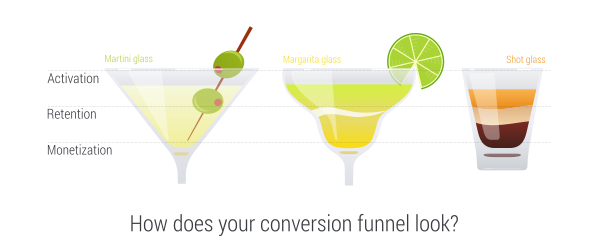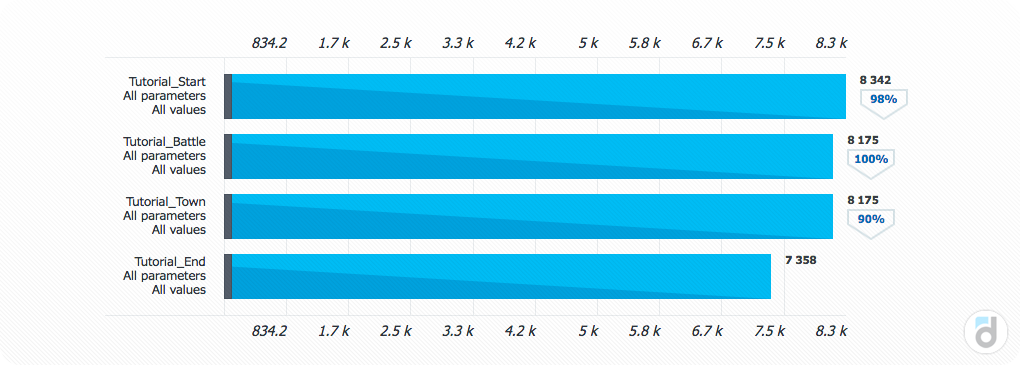9 tips for setting up application analytics

Modern analytical systems mostly work on the basis of events (or events). An event is any user action in the application recorded by the analytical system. Most often, analysts choose such events:
- registration of the user or his first visit;
- entrance to the application;
- payment (whether for virtual or real currency).
These three events are enough to calculate the metrics of user retention, their activity and monetization - that is, to answer 80% of questions to the analytics. But do you need these 80%?
Most projects say no, and rightly so. For a detailed study of users, information about other events is needed: click on the button, fight in the game, tutorial passing, and so on. Such events are called custom, and they are configured separately for each application.
Customization of custom events is a very important task, because properly configured events simplify the work with the product and demonstrate the problems experienced by the user. The event system helps to find bottlenecks and growth points in the application, so we decided to share a few tips on how to set up data collection for analytics.
Tip 1. Do not delay setting up events for later.
Often it turns out this way: first, we will upload the application to the store, see how it goes, and then, if anything, add event tracking. Do not do it this way! Iteration of adding events to the application is not a quick process, given the update in the store, and it is better to start it at the design stage. Otherwise, if the indicators after the launch will be so-so, you can not draw the right conclusions and make changes to the application in time.
')
During development, you know in advance the key points through which the user will pass - so why delay the addition of events for later?
Tip 2. Use event parameters.
Along with information about the event, you can also transfer to the analytical system many parameters of this event: the time it takes to complete a level, the result of a battle, the number of attempts, the amount of virtual currency spent, etc. And then these parameters can be used in any reports, including funnels.
Setting parameters reduces the number of transmitted events. For example, instead of the Battle_Win and Battle_Lost events, you can pass the Battle_Finish event and the Result (0/1) parameter as its result. This approach will greatly simplify further analysis.
Tip 3. Use global options.
In the event, you can pass parameters not only events, but also the user. For example:
- Registration date Subsequently, you can do a cohort analysis: compare the behavior of users registered at different times;
- Level. This will help balance the difficulty levels, the amount of currency issued, etc .;
- Source of traffic You can create funnels for users from different sources. For example, compare the activation funnel for users coming from Facebook and Google;
- Tag paying / non-paying. You will be able to share the analysis of the behavior of paying and non-paying users, and this will answer the question of why some pay, while others do not. Maybe the currency is too much? Maybe a technical error at the stage of payment?
Global parameters are called global, because analysts recommend using the same set of them in all monitored events.
Tip 4. Draw funnels in advance.
At least on paper. If you know in advance what reports you want to create, it will be easier for you to identify key events. You will be able to mentally bring the most important points of the application and imagine what precedes these points.
Tip 5. Analyze the first session as detailed as possible.
The first session is really important, because it is in it that the user receives answers to the questions: what is this application? How is it different from others? why do I need this? how much is it?
The first session lays the groundwork for retaining and monetizing users. Every minute step of the first session is the point where the user decides whether he will remain in the project. We recommend that you track the first session in as much detail as possible to eliminate all bottlenecks.

Screenshot taken from devtodev system.
Tip 6. Only confirmed purchases.
A very common mistake: if the user clicks Buy, the application sends information about the purchase to the system. But then he can then cancel the payment, he may not have funds on the card, etc. As a result, the data from the server and from the system are different, and the wrong data is even worse than their absence.
Tip 7. Duplicate information into two systems.
One of them may be paid (main), and the other - free. This does not oblige you to anything, you simply place not one line of code at the key points of the application, but two, but check the accuracy of the analytics.
Tip 8. Test, test and test again.
As we have said, adding events to the application is not a quick thing, it is worthwhile to approach it thoroughly. Forgot to pass one parameter - you have to wait a month until it is added. And one more month until all users update the application.
Better to do everything in advance. Record at least your own session and see if all events are transmitted correctly, whether you have forgotten any parameters, and if there are any obvious errors.
Tip 9. Approach the event system structurally.
It often happens that literally every control element on every form hangs. As a result, there are hundreds of names of events in analytics, of which only 5-10 actually fall into reports. In addition, most analytics systems build their pricing based on data points. Each line that is transmitted to the analytics system is a data point. The event is a data point. And such a thoughtless approach can cost you dearly enough.
The other extreme is to assign events to only a few key points in the project, and then find out that this amount of data is not enough to answer important questions about user behavior. As in any business, here you need to find a balance and keep track of really important events.
Setting up events is a serious task when managing a project, because it is the tracking of custom events that allows you to find problem areas and growth zones. There are good algorithms for determining the structure of events, and we will talk about them at the webinar “Events and funnels: how not to miss the most important thing” , which will take place on March 16 at 18:00 Moscow time . We will analyze real cases of building the structure of project events, learn how to correctly form and interpret the funnels, so as not to lose users from the hands. Join now!
Source: https://habr.com/ru/post/299230/
All Articles